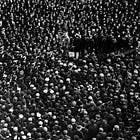The Necessary Conditions for Propaganda to Be Effective
Not every society is ready to be propagandized and not all societies are equally receptive to it. So what conditions make a society fertile ground for the propagandist?
Perhaps more so than any other nation, propaganda is permanent feature of American society, an essential element that makes America uniquely “American.” An argument could be made that out of all the modern nations, America is the place where all of the necessary conditions for being a fully propagandized society are there. A common propaganda trope is this divide between individualism and collectivism. On the one hand you have the image of the self-made, rugged individualist, the lover of freedom and democracy and on the other is the dreaded collectivist, the communist and his proletariat, the cultural Marxist and his identity groups. Ellul argues that we should properly understand that the perfect ground for the propagandist is a society that is both individualist and a mass society. America, with its strong emphasis on individualism, is a fertile ground for the propagandists.
Most of the messaging we receive, especially from many who think of themselves as on the right, is individualism is in opposition to mass society or collectivism, that they are a binary, that a society is either individualist or collectivist. But the stark reality is that an individualist society, especially in an age of mass media, mass communication and easy mobility, must also be at the same time a collectivist society. True individualism requires the breakdown of the strong organic social networks and communities which are the ordinary foundation of society. But when individuals are not held together in these tight knit social groups and networks, they can only exist then as a mass society. If you have a collection of individuals, you don’t have a society. If the individual is not integrated into tight knit organic communities, and you still have a society, then the individual must be part of a “mass.” We talked about this “person-in-mass” in our previous pieces on this subject.
In a mass democracy we talk about the equality of persons. This idea that each person is more or less equal to or the same as other people, that people are interchangeable, renders the person an abstraction. The “individual” is not really a fully rounded human being, but rather, becomes merely identified as part of the average, the “average American.” The average American is no longer a real person. He is part of the mass. As long as there are real organic groups of people, real communities, a society cannot be individualistic. There can be persons and individuals, but a society cannot be individualistic without social breakdown. Once a society is individualistic, if it to remain a cohesive whole, it must become a mass society, a collection of artificial connections. Mass media, to be truly and fully propagandistic, must capture the individual and the mass at the same time. Integration into an organic, unchosen group or community protects you against propaganda. These groups are not as easily penetrated by propaganda. Although they are not immune to its effects, they are are more resistant than is the individual. This is why the breakdown of family, church and community are a necessity for propaganda to be fully effective.
If we remember that one of the most prevalent forms of sociological propaganda comes to us in the form of product advertising, we must come to grips with the realization that the modern commercial society, the so-called “free market,” requires standardization to facilitate economies of scale. In order to take advantage of the reduction in the cost of goods that comes from manufacturing them at scale, you not only need to standardized your supply chain and production, but you must also standardize your markets. Everyone must be buying the same goods produced at the same factory. In order to standardize society, it must be broken down. Communities, social groupings, especially groups like churches, must be undermined so as to create a mass consumer society. Many who think of themselves as “conservative” also think of themselves as being supporters of “free markets” and a capitalist economy. But when examined closely, the drives of the market towards economies of scale are directly hostile to the very things that conservatives are supposed to value the most: faith, family, communities. The market needs to undermine all of these in order to produce a mass market to which mass produced standardized goods can be sold to a standardized mass society. That standardized society is made up of the “individual-in-mass.” It is propaganda, mostly through product advertising, that welds the individual into the mass.
Why is the individual, rather than being a source of strength, a bulwark against collectivism, instead at his most vulnerable to the manipulations of the propagandist when he is an individual? The individual, once isolated, must become the sole measure of all things. He must determine truth and falsehood for himself. He must make all of his own choices without the aid of others. Psychologically, this places a huge burden upon the individual. He cannot possibly possess all the knowledge he needs to determine what is true and false, what he must do in every situation. So, he embraces the message of the propagandist to ease this psychic and spiritual burden. But he does so believing that he still remains the sole arbiter of truth. He believes he is making his own critical judgements about the news or the choices he makes in his daily life, when in reality he is fully integrated into mass society. In this regard, it is not enough that the economic and political forces that undermine communities simply dissolve them, they must at the same time be reconstructing people and integrating them into the new realities of mass society. For example, you lose attachment to your church and ethnic community and are reintegrated into the mass of society as a “white person.” Mass society requires a combination of minimum density, a weakness of local social structures, but then also conditions where current opinions are strongly felt and people are organized into inorganic collectives where they are psychologically unified, they all share the same ideas and think more or less the same way. In a mass society, all forms of “diversity” are mostly superficial and largely illusory.
In the same way, in a mass society the symbols, archetypes, stereotypes, the myths, the stories, its history becomes separated from a reality that is grounded and fixed. They are abstracted and rationalized so as to be turned into the content of propaganda. All of these symbols with their deeply spiritual, mystical and religious nature are shifted and made into political realities. The society is no longer permitted to be religious or to have an organic culture of its own. Its attention must be drawn into the political realities of the nation at scale, the reality of the mass society. The realm of the mass society is that of politics, not religion.
Because propaganda works best in situations where there is a minimum amount of density and where people have been broken away from organic communities, Ellul argues that the cosmopolitan “diverse” city and suburb allows for easier penetration of propaganda. Propaganda is more of a suburban and urban thing, than it is a rural thing. This helps to explain the growing divide between the more liberal voting cities and the more conservative voting countryside.
In organic communities, the formation of opinion depends upon direct personal contact between people over time. Opinion tends to impose itself on the group automatically and mimetically. Leadership within the community tends to arise spontaneously. This type of social arrangement is what is natural for humanity. Organic communities are at once simultaneously democratic and hierarchical. Opinion, once it is formed, is those things which are self-evident to everyone and held together in the collective memory of the people. What they know are the things that are known. Any “minority” person who enters into the community is looked upon as a foreign body from which the community must be protected. Real communities are not liberal. When someone steps out of line in terms of action or opinion, the sanctions applied are generally diffuse, but vigorous. Even though opinion is shared by all, there is no equality. People accept leadership and they recognize authority. This authority is centered around the father’s role in the family. Dominant personalities will play a considerable role and group opinion will form spontaneously around these people because of their personality and the authority they wield as a result.
Once the community is broken down and the people are reconstituted into a mass, generally what happens is that while the label “leader” persists, the role of community leadership is replaced by propaganda. Those who fill the role of “leader” or “expert” are not actually set apart from the people by the force of their personality or natural charisma. They are not your “betters.” They are not part of a different class. They are not nobles. The leader/manager and the expert are very much part of the mass. The people who “lead” must be seen as one of us, as just another ordinary man. It could be any one of us in that position. There is nothing special about the leader or the expert in a mass society. The leader cannot be a transcendent figure. Even the Hero must be seen as part of the mass. The leader/manager is merely a reflection of the mass.
Ellul argues that in any mass society where there is no community forming opinion organically, the opinions of the mass, what we call public opinion, has identifiable characteristics.
Institutionalized channels must give people “official” information. This official information is the basis upon which public opinion is formed. Opinion is expressed through official channels, like an election, or through a political party or letters to the editor.
People will share almost identical opinions when they should not be able because they have no organic contact with each other. Their lives are different. They live in different locations. Their work is different. They move in different social circles. They are not an organic unity. They should think as much alike as they do, but they do. Their thoughts are almost the same.
When people are in a mass society their opinions are almost always abstracted and not connected to the events of their day-to-day lives. Opinions in a mass society almost always rest on problems which do not correspond to reality. Propaganda works best when secondary opinions overwhelm and reduce primary opinions to the minority.
This bears some comment. When Ellul was writing this in the 1950’s, media control was much more centralized and the institutions of mass society like political parties played a much bigger role. With the advent of the internet and especially social media, this kind of centralized control has been, to a degree, broken up. The second point above, though, still remains largely true. People who would not otherwise be connected are now connected through these new methods of mass communication. And while media like the YouTube or Discord podcast, the Substack long form article, and social media like Twitter, Instagram, Facebook and Tiktok, have been disruptive to centralized regime control of information, because these are all media of mass communication, they are all at their core propagandistic. What they allow for is the emergence of a counter propaganda. As we will discuss in a subsequent piece, just because you have been freed from a centralized propaganda, does not thereby mean that you are ready to think for yourself. Generally, you need to be re-programmed. Because much of the content on the internet and social media is directed to you algorithmically, while the content appears to break free from dominant narratives, beneath the surface you are being directed towards certain content and away from other content. Because of the nature of social media, it seems that what is happening is a process of mutual self-propagandizing. Social media has all the characteristics of the mass. The channels have shifted, but they are still narrowed to a select few mass communication media. There are no real leaders and those that do “lead” are still very much part of the mass. And much of the dialogue still focuses on secondary issues.
In regards to this last point, we are in an odd space. What is happening is that events which used to be remote, like say mass immigration, are now have real world effects on people. But the main media outlets are using their power of selection to not talk about the issue. Social media has been a mechanism whereby issues that lay outside of the mainstream narrative are given voice. Immigration is one example. The effects of inflation is another. In other areas, though, social media allows the actual real world effects of modernity to be acted out in a variety of mass phenomenon, like the whole transgenderism phenomenon. What began as a social media phenomenon — likely initiated by hardcore activists — among teens was picked up by the broader academic, medical and policy making networks and became a central part of regime propaganda. This is having a real impact in the lives of people. But it is still a secondary issue. Transgenderism is a secondary response to the primary effects of modernity, the technological society, social breakdown upon the lives of the citizenry and the alienation this causes. Transgenderism is a symptom. We spend time talking about symptoms and not causes. Mass immigration is having its effects, but it too is a symptom and not a cause. So, yes, social media allows us to “notice” things that previously we were kept from noticing by centralized regime control of all media outlets. But social media is still a medium of mass communication. It is still a medium of centralized control. The relationships formed are formed through the medium and mediated by the medium with its interface and algorithms. Social media is still not organic and the issues you discuss are often secondary and determined by “the current thing” which is being talked about today. Social media is still a medium of control. Remember, that propaganda is necessary in a mass society to keep it running smoothly. Social media continues to play that role.
We tend to want to believe the narrative that social media is bringing an end to the hegemonic propaganda control that the state has over the information we receive. I think this is a dangerous illusion. You are not freed from mass communication merely by switching which form of mass communication you use. The individual capable of truly forming his own opinions is rare. Even the independent thinker is always shaped by his time and place and the things which he has been taught and the works of others he has absorbed. We are mimetic beings who absorb and imitate those around us. Your options are not between propaganda and freedom, or propaganda and self-determination. Your choice is between being shaped by an organic community of real people with whom and against whom you can both learn and push back against to create a boundary between the self and the other; or you can be “freed” from the community to become part of mass society, shaped by the forces of propaganda. Once we are “liberated” from the smothering communities of old, the truth is that we hunger for propaganda. We want it. We create the conditions whereby we allow ourselves to be propagandized.
“Where not enough TV sets are in use it makes no sense to conduct propaganda via TV…but the act of acquiring a set brings up a point we will discuss at considerable length: the complicity of the propagandee. If he is a propagandee it is because he wants to be, for he is ready to buy a paper, go to the movies, pay for a radio or a TV set [or go on social media]. Of course he does not buy these in order to be propagandized — his motives are more complex. But in doing these things he must know that he opens the door to propaganda, that he subjects himself to it. Where he is conscious of this, the attraction of owning a radio is so much greater than the fear of propaganda.”
We generally like to think about propaganda as the evil propagandist manipulating innocent people. But the truth is that we invite the propagandist to control our thoughts and actions. And perhaps, because of the alienation of modern life there is a real sense that we need propaganda, we want it, we welcome it because without it life would be too hard. We have to accept that we want to be propagandized.
“He wants to submit to this influence and exercises his choice in the direction of the propaganda he wishes to receive. If by chance he finds in ‘his’ newspaper an article he dislikes or an opinion that deviates a little from his own, he cancels his subscription.”
This is how we should properly view social media. It is not a break from the propaganda which maintains the unnaturalness of modern society, but rather merely the cancelation of our subscription to one outlet of propaganda so as to embrace a different one which is more to our liking and causes us less psychic anxiety. All mass media, including social media, creates its own loyal public which is an effect of the media itself. The act of buying a newspaper, a radio, a TV, a computer with an internet connection, a smartphone, signals that the person wants to be part of the mass, to be integrated into mass society, that he welcomes the effects of propaganda in his life.
To facilitate this, for propaganda to really take root in the modern society, you need an average standard of living such that the ordinary person can purchase the means of their integration into mass society through propaganda. Yes, as we have discussed, the propaganda of agitation, agitprop, does work on the poor, but far more important is the integration propaganda that works on the working and middle classes. Being trained by propaganda requires a certain degree of freedom from the primary issues of food, shelter, clothing. Integration into mass society through propaganda is a leisure activity. Because of this, the working and middle class are very susceptible to propaganda. Propaganda, as a mass phenomenon, is for the average person. The people who create propaganda — that includes both propaganda and counter-propaganda — come almost exclusively from the ranks of the upper middle class.
The role of propaganda is primarily that of “adjustment.” It’s primary aim to produce well socialized people who are properly adjusted to life in the modern industrial and information economy. To survive in this world you must be “well-adjusted,” you must be “normal,” and conform to a certain way of life. Your aspirations and goals must be the same as everyone else. You must want a normal life and a normal standard of living. And to be properly propagandized you need a minimum level of culture and education. This is the role of public schooling. It provides you with enough reading skills, enough social aptitude so that you will be perfectly and uncritically adapted by propaganda. Public education exists to make you as a person susceptible to propaganda, used to its influences. Because public schooling deals in averages, and this includes your university education, there is almost no chance of raising your education level enough to compensate and free a person from propaganda.
“Propaganda techniques have advanced so much faster than the reasoning capacity of the average man that to close this gap and shape this man intellectually outside the framework of propaganda is almost impossible.”
Taking this black pill is important. In the end we must realize that:
“Propaganda itself is our culture.”
In mass society, the enculturation process is the process of propaganda. Teachers teach reading and indoctrinate people at the same time. And a remarkable number of propaganda campaigns and efforts begin within the culture and arts setting. Propaganda is our culture. Every medium of art, culture and entertainment, including sports, are a form of propaganda. Not just at the level of content, but at the level of structure as well. Participation in organized sports is participation in the socialization mechanisms of society. Organized sports are a form of public schooling and should be seen as an avenue for integration into mass society.
We all like to think of ourselves as immune to propaganda, but that too is a mistake.
“Naturally, the educated man does not believe in propaganda; he shrugs and is convinced that propaganda has no effect on him. This is, in fact, one of his great weaknesses, and propagandists are well aware that in order to reach someone, one must first convince him that propaganda is ineffectual and not very clever.”
In terms of other conditions, the more that information becomes a central part of society, the more conducive an environment to propaganda it becomes. There is no distinction between information and propaganda. The idea that you can have an informed opinion is essential for making propaganda work effectively. You cannot do propaganda properly unless the subject is already immersed into an information environment. The more information that a person absorbs, whether intentionally or not, makes him more vulnerable to propaganda and the propaganda more effective. The best propaganda does not base itself on errors, but rather shapes exact facts, precise information, sifting, selecting and sorting, fixating our attention on certain information, framing it for us, giving it meaning. The more informed you are, the more you face the problem of integrating all the information that you are attempting to absorb. When information becomes a problem, it is the propagandist that teaches you what to notice and what to ignore. It is the propagandist that organizes the information for you, showing what it means. Thinking that you alone are uniquely capable of processing all of the information makes you especially vulnerable to manipulation, whether by the propagandist or the counter-propagandist.
Up next: we will discuss the necessity of propaganda for modern life.









You appear yo be describing water to a fish. Nice job!
What about the Amish? They have been more or less left alone. Why do they get a pass?